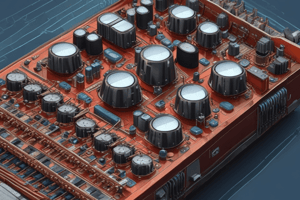Podcast
Questions and Answers
What is the primary advantage of an op amp's high input impedance?
What is the primary advantage of an op amp's high input impedance?
- To reduce the output impedance
- To increase the gain of the amplifier
- To minimize loading effects on the input signal (correct)
- To increase the bandwidth of the amplifier
What circuit analysis technique involves breaking down complex circuits into simpler components?
What circuit analysis technique involves breaking down complex circuits into simpler components?
- Superposition (correct)
- Thevenin's Theorem
- Kirchhoff's Laws
- Node Analysis
What determines the maximum rate of change of the output voltage in an op amp?
What determines the maximum rate of change of the output voltage in an op amp?
- Bandwidth
- Slew Rate (correct)
- Output Impedance
- Input Impedance
What is the frequency range over which the op amp can amplify signals?
What is the frequency range over which the op amp can amplify signals?
What type of amplifier configuration amplifies the difference between two input signals?
What type of amplifier configuration amplifies the difference between two input signals?
What is assumed to be infinite in an ideal op amp?
What is assumed to be infinite in an ideal op amp?
What is a limitation of real op amps, resulting in a non-ideal frequency response?
What is a limitation of real op amps, resulting in a non-ideal frequency response?
What is the product of the gain and bandwidth of an op amp?
What is the product of the gain and bandwidth of an op amp?
Flashcards are hidden until you start studying
Study Notes
Op Amp Characteristics
- Input Impedance: High input impedance (typically >1MΩ) to minimize loading effects on the input signal.
- Output Impedance: Low output impedance (typically <100Ω) to maximize output current capability.
- Gain: High open-loop gain (typically >10^5) to amplify small input signals.
- Bandwidth: Limited frequency range over which the op amp can amplify signals.
- Slew Rate: Maximum rate of change of the output voltage, limiting high-frequency performance.
Circuit Analysis
- Node Analysis: Analyze op amp circuits by finding the voltage at each node, using Kirchhoff's laws.
- Superposition: Break down complex circuits into simpler components, analyzing each separately.
- Thevenin's Theorem: Simplify circuits by replacing complex networks with equivalent Thevenin sources.
Frequency Response
- Low-Frequency Response: Op amps typically have a low-frequency cutoff, below which the gain rolls off.
- High-Frequency Response: Op amps typically have a high-frequency cutoff, above which the gain rolls off.
- Bandwidth: The range of frequencies over which the op amp can amplify signals.
- Gain-Bandwidth Product: The product of the gain and bandwidth, a constant for a given op amp.
Amplifier Configurations
- Inverting Amplifier: Amplifies the input signal, but inverts its polarity.
- Non-Inverting Amplifier: Amplifies the input signal, without inverting its polarity.
- Differential Amplifier: Amplifies the difference between two input signals.
- Summing Amplifier: Amplifies the sum of multiple input signals.
Ideal Vs. Real Op Amps
- Ideal Op Amp: Assumed to have infinite gain, infinite input impedance, and zero output impedance.
- Real Op Amp: Has limitations, such as finite gain, input impedance, and output impedance, as well as non-ideal frequency response.
- Non-Ideal Effects: Real op amps exhibit non-ideal effects, such as input bias currents, offset voltage, and common-mode rejection ratio (CMRR) limitations.
Op Amp Characteristics
- High input impedance (typically >1MΩ) minimizes loading effects on the input signal.
- Low output impedance (typically 10^5) amplifies small input signals.
- Op amps have a limited frequency range, known as the bandwidth, over which they can amplify signals.
- Slew rate is the maximum rate of change of the output voltage, limiting high-frequency performance.
Circuit Analysis
- Node analysis involves finding the voltage at each node using Kirchhoff's laws.
- Superposition involves breaking down complex circuits into simpler components for analysis.
- Thevenin's theorem simplifies circuits by replacing complex networks with equivalent Thevenin sources.
Frequency Response
- Op amps have a low-frequency cutoff, below which the gain rolls off.
- High-frequency cutoff occurs when the gain rolls off above a certain frequency.
- Bandwidth is the range of frequencies over which the op amp can amplify signals.
- The gain-bandwidth product is a constant for a given op amp.
Amplifier Configurations
- Inverting amplifiers amplify the input signal, but invert its polarity.
- Non-inverting amplifiers amplify the input signal without inverting its polarity.
- Differential amplifiers amplify the difference between two input signals.
- Summing amplifiers amplify the sum of multiple input signals.
Ideal Vs. Real Op Amps
- Ideal op amps have infinite gain, infinite input impedance, and zero output impedance.
- Real op amps have limitations, such as finite gain, input impedance, and output impedance.
- Non-ideal effects in real op amps include input bias currents, offset voltage, and CMRR limitations.
Studying That Suits You
Use AI to generate personalized quizzes and flashcards to suit your learning preferences.




